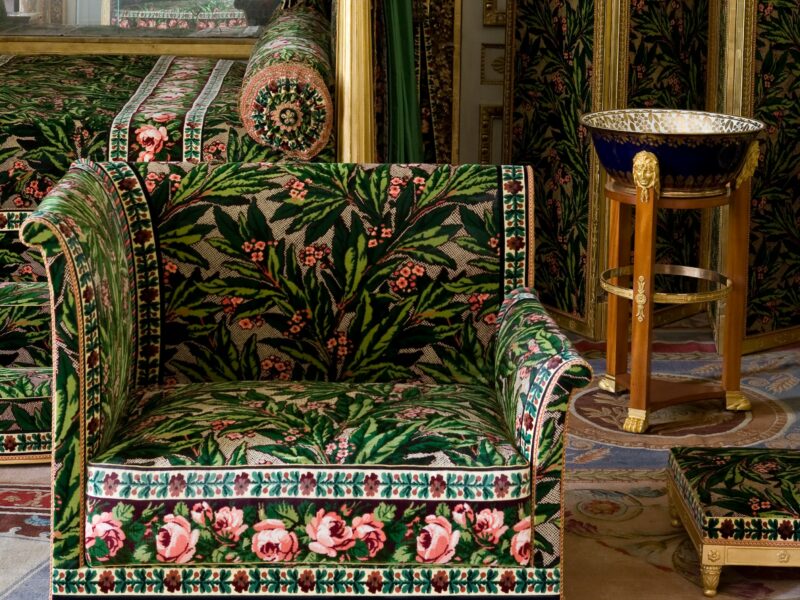
1.The Emperor had the château refurnished in 19 days
For the arrival of Pope Pius VII in 1804, Napoleon had the château of Fontainebleau, which had been emptied during the Revolution, refurnished in what was said to be 19 days. He urged Charles Percier and Pierre Fontaine, architects working for him in Fontainebleau, to give a fitting welcome to the Pope, who had come to crown him Emperor in Paris.
2. The Emperor had the future Napoleon III baptised in the Chapel of the Trinity
On 4 November 1810, in the Trinité chapel, a number of princes close to Napoleon were baptised. Among them was the son of Louis, King of Holland, and Queen Hortense, Josephine’s daughter, a prince named Louis-Napoléon, who would become Emperor Napoléon III a few decades later.
3. The château has preserved his bicorne, frock coat and coronation sword, among other items
The famous bicorne worn “in battle”, with the wings in line with the shoulders, and the redingote, the coat worn by the Emperor on the battlefield, have gone down in history and are enough in themselves to evoke Napoleon’s famous silhouette. A copy of each of them, which belonged to the Emperor, as well as the famous coronation sword, are kept in the Napoleon I Museum at the Château de Fontainebleau.
4. The Ecole Spéciale Militaire was born at the château de Fontainebleau
Founded by Bonaparte, then First Consul, on 1 May 1802 in Fontainebleau, the Ecole Spéciale Militaire was housed at the château, notably in the wings surrounding the cour du Cheval Blanc, now the cour d’Honneur. In order to reserve the château for his court, the Emperor had the school transferred to Saint-Cyr in 1808.
5. Napoleon studied day and night in his private library
Napoleon, a hard worker, had his private library set up in the Petits Appartements for private use, as well as an adjacent topographical cabinet in which he could consult large maps. This private library differed from the palatial library, which was used by the entire court residing at the château de Fontainebleau and was located in the Grands Appartements d’apparat.
6. Napoleon had a throne room fitted out in the château: the only one preserved in its original state
The throne room at the château de Fontainebleau is the only surviving Napoleonic throne room in the world. Formerly the King’s bedroom, it was refurbished in 1808 at Napoleon I’s request. The throne was installed in the place formerly occupied by the bed.
7. Napoleon imprisons the Pope at Fontainebleau
Pius VII, kidnapped by night from his palace on the Quirinal in Italy in July 1809, and for a time shunted around the French Empire, was forcibly transferred to Fontainebleau, where he arrived on 19 June 1812. He was held captive in the former flat of the Queen Mothers (now the Pope’s flat) until January 1814.
8. The Emperor signs his abdication at the château de Fontainebleau and attempts suicide there
On 2 April 1814, the Senate voted to depose Napoleon. On 4 April, secluded in his flat in Fontainebleau, the Emperor was forced to abdicate in favour of his son. On 6 April, he abdicated a second time, definitively renouncing the throne for himself and his family. On the night of 12 to 13 April, having lost everything, he tried to poison himself in his room at Fontainebleau.
9. The Emperor bids farewell to his guard on the Horseshoe Staircase
Forced to leave Fontainebleau for the island of Elba, Napoleon staged his famous farewell to his guard on 20 April 1814. After a memorable descent of the Horseshoe staircase, the Emperor made a poignant speech to his soldiers in a courtyard of honour that would go down in history as the “Courtyard of Farewells”.
10."Fontainebleau is the true home of kings, the house of centuries", Napoleon I
In exile on St Helena, Napoleon remembered the palace of Fontainebleau, to which he was very attached and which he restored in the service of his power, as “the true home of kings, the house of the centuries”.
Don't miss
If you want to feel at the heart of the events that marked the reign of Napoleon I at the château de Fontainebleau, come and relive Napoleon’s farewell to his guard, 210 years later. Immerse yourself in 1814 for an exceptional weekend on 20 and 21 April 2024!